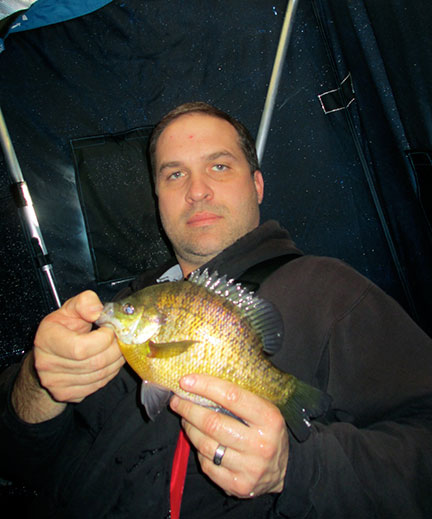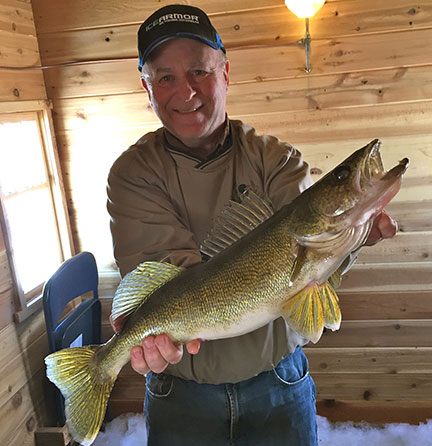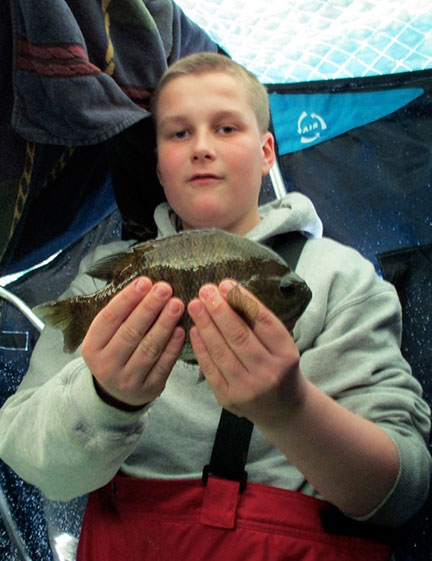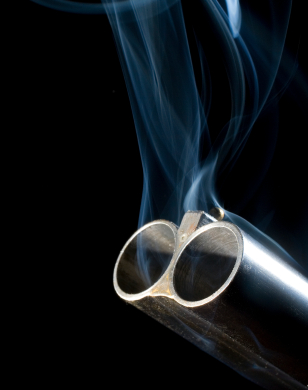By Steve Weisman

Author’s son, Curt Weisman with a big gill taken sight fishing on West Lake Okoboji. (photo by Steve Weisman)
My favorite ice fishing occurs when I can sight fish, actually watch the action below the ice with my own eyes. To me, it’s the ultimate. To be able to watch the fish approach the lure, to see its response to the presentation and then (hopefully) the resulting strike – or if not, the resulting refusal. That is the total package as far as I am concerned.
Yes, I know that flashers will show us fish approaching, fish moving up and down with the lure and when the fish is in the hot zone. Most of the time that is good enough. When the fish hits the hot zone, keeping the same presentation going will often trigger a strike. HOWEVER, sometimes the strike doesn’t happen. The fish is there in the hot zone and then it slowly slips away. Why? What happened? That’s the very reason I relish the chances to sight fish.
The lake to sight fish
West Lake Okoboji! Yup, it’s known for its gin clear waters, when you can often see down nearly 20 feet! What a rush it is to be able to see everything. That gin clear water is what brings ice fishermen from across the Midwest to West Lake every winter: the chance to go head to head with its finicky big bluegills. I’ve gone head to head with them for the past 35 years! We might be in the 3-4 foot shallows, the deeper 10-12 foot weedbeds and on up to the 15-18 foot deep weedlines.
The challenge
To sight fish, you must come equipped with a good portable shelter that will block the light so you can see down the hole. Now, when the fish come in, we will see exactly what they are doing and how they respond to our presentation. If enough fish are in the area and enough are attracted to our bait, we begin to see a pattern establish itself. If we pay close attention, we can soon refine our presentation to get a majority of the fish to strike.
Since these bluegills are sight biters, it is important to have the right equipment. I very seldom use anything heavier than two-pound test line and small jigs. I’ve gone to using the Dave Genz Drop Series of tungsten jigs in the 1/64-ounce and 1/32-ounce sizes. They are tough, can get to the bottom quickly, and yet fish light. As for bait, it’s your choice. Some anglers have to use live bait: wigglers or wax worms. I do sometimes, but for the most part have gone to using plastics. Maki Soft Plastics and Berkley’s powerbaits both work well.
The presentation is what I call the “Okoboji jiggle.” It’s not a jerk; it’s not a jig. It’s a quick paced consistent jiggle, jiggle, jiggle. Don’t worry; the bluegills will let you know if you are jiggling correctly or not. Each day, each hour can be different. So you let the fish tell you what they want.
To give you an idea of what to expect, here are a couple of typical scenarios that I have experienced many times. Although there are times when it seems as if they will bite anything you throw down the hole, more often than not, it’s much harder than that.
Example #1
Often the bluegills will swim right in, right toward the bait and then stop… and stare and stare at the bait less than an inch away. Remember, they are sight fish, so everything that happens in their lives happens in clear water. Keep doing exactly what you were doing when they came into view. To change, to quit, to go faster will often just send them off. Keep doing what you were doing! That will work, most of the time. However, there are times (especially during the middle of the winter) when they are really lethargic that they won’t hit anything.
Example #2
It’s easy to miss a bite. I’ve had this happen many times, because the point of the hook is not turned in the direction of the incoming fish. They can inhale the jig and spit it out, and you’ll never touch them. You have to make sure that the point of the hook is facing the fish. If it’s not, slowly turn the jig, but don’t spin the jig, so that the hook faces the fish. However, keep jiggling the jig exactly as you did when you first saw them. They will stare and stare and stare…don’t change anything.
Case in point, I remember a time last winter when the bluegills were very finicky, almost lethargic and came through only one at a time. They moved slowly, and approached my bait almost hesitantly. They would come right up to it and stare and stare and stare. If I changed my presentation (a tight jiggle, jiggle, jiggle), they would stop and just hover there…and then they would slowly fin back and away, moving at an extremely slow place.I found, however, if I continued the same jiggle, and I did not vary it, they would very slowly come…nose to bait…and then inhale it. Sometimes, however, it was only the tip or maybe it was the middle or the head of my tiny jig. So, I had to also adjust to that and set the hook at exactly the RIGHT time. Sometimes, yes, sometimes, no! However, I did take a nice mess of 8-9” gills home with me.
Example #3
Sometimes things change. On this day, it began the same way as the first day. However, after about an hour, everything changed. I used the same bait, the same jiggle. A gill would appear, come straight toward the bait and inhale it. They were just plain aggressive (almost made me think I knew what I was doing!) At times, I’d even have 5-6 gills come from different directions right toward my jig. Exciting, you bet. However, it also caused troubles. They would sometimes cut each other off at the pass. Sometimes they would even bump into each other in their desire to get to their “food.”
When that happened, it kind of sent a shock wave through the bunch, and they would just sit there, trying to decide whether they should continue toward the bait or not. Sometimes one or more than one would continue on. At other times, they would all move away. Sometimes one single gill would come rushing right toward the bait so hard and fast that it would misjudge its approach and slide right on by. Often, it would swing around and come back. Other times it would just continue on.Still, the presentation had to be consistent with what brought them into the strike zone. Any change or even stopping would shut them down right now!
Mission accomplished!
That’s the way I look at every time I am on the ice sight fishing for bluegills. Whether the fish win or I win, I feel that the mission has been accomplished, because I have been able to battle wits with the finicky bluegills on the gin clear waters of West Lake Okoboji.














